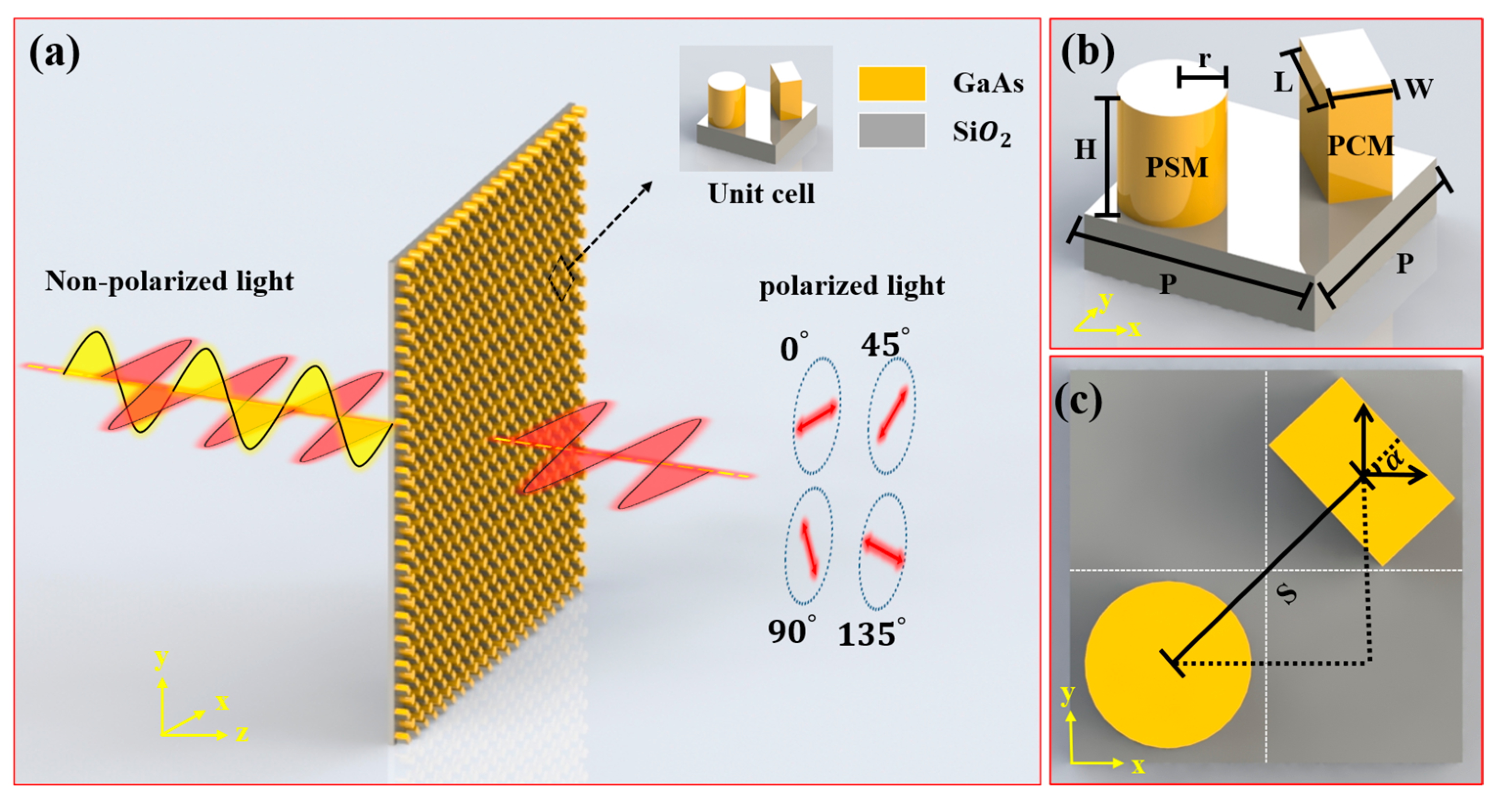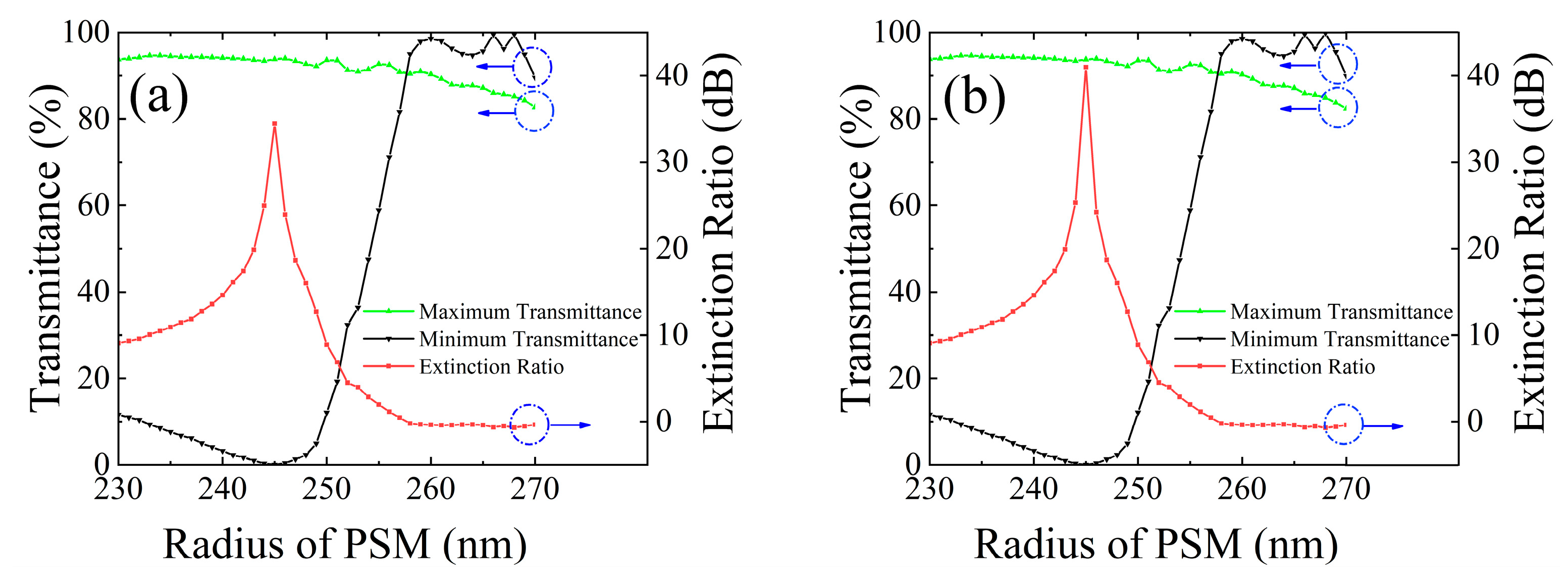GaAs Linear Polarizer with a High Extinction Ratio for Extended Short-Wave Infrared Detection
Abstract
1. Introduction
2. Structure and Theoretical Analysis
3. Design and Numerical Simulation
3.1. Determine the Operating Wavelength
3.2. Performance Evaluation with the Transmittance and Extinction Ratio
3.3. Performance Optimization with the Major Polarization Angle and the Degree of Linear Polarization
4. Conclusions
Author Contributions
Funding
Data Availability Statement
Conflicts of Interest
References
- Hoang, A.M.; Chen, G.; Haddadi, A.; Abdollahi Pour, S.; Razeghi, M. Demonstration of shortwavelength infrared photodiodes based on type-II InAs/GaSb/AlSb superlattices. Appl. Phys. Lett. 2012, 100, 211101. [Google Scholar] [CrossRef]
- Dehzangi, A.; Haddadi, A.; Chevallier, R.; Zhang, Y.; Razeghi, M. Fabrication of 12 µm pixel-pitch 1280 × 1024 extended short wavelength infrared focal plane array using heterojunction type-II superlattice-based photodetectors. Semicond. Sci. Technol. 2019, 34, 03LT01. [Google Scholar] [CrossRef]
- Nordin, G.P.; Meier, J.T.; Deguzman, P.C.; Jones, M.W. Micropolarizer array for infrared imaging polarimetry. J. Opt. Soc. Am. A 1999, 16, 1168–1174. [Google Scholar] [CrossRef]
- Chu, J.; Wang, Z.; Guan, L.; Liu, Z.; Wang, Y.; Zhang, R. Integrated polarization dependent photodetector and its application for polarization navigation. IEEE Photonics Technol. Lett. 2014, 26, 469–472. [Google Scholar]
- Intaravanne, Y.; Chen, X. Recent advances in optical metasurfaces for polarization detection and engineered polarization profiles. Nanophotonics 2020, 9, 1003–1014. [Google Scholar] [CrossRef]
- Haddadi, A.; Chevallier, R.; Dehzangi, A.; Razeghi, M. Extended short-wavelength infrared nBn photodetectors based on type-II InAs/AlSb/GaSb superlattices with an AlAsSb/GaSb superlattice barrier. Appl. Phys. Lett. 2017, 110, 101104. [Google Scholar] [CrossRef]
- Rui, W.; Li, T.; Shao, X.; Li, X.; Gong, H. Research on polarizing performance of Au-SiO2 sub-wavelength hybrid grating in short wave infrared (SWIR). In Proceedings of the 7th International Symposium on Advanced Optical Manufacturing and Testing Technologies: Optoelectronics Materials and Devices for Sensing and Imaging, Harbin, China, 26–29 April 2014; SPIE: Washington, DC, USA, 2014; Volume 9284, pp. 11–16. [Google Scholar]
- Zhou, J.; Zhou, Y.; Shi, Y.; Wang, F.; Xu, Z.; Bai, Z.; Chen, J. A compact polarization-integrated long wavelength infrared focal plane array based on InAs/GaSb superlattice. Sci. China Inf. Sci. 2022, 65, 122407. [Google Scholar] [CrossRef]
- Lin, D.; Melli, M.; Poliakov, E.; Hilaire, P.S.; Dhuey, S.; Peroz, C.; Klug, M. Optical metasurfaces for high angle steering at visible wavelengths. Sci. Rep. 2017, 7, 2286. [Google Scholar] [CrossRef]
- Grady, N.K.; Heyes, J.E.; Chowdhury, D.R.; Zeng, Y.; Reiten, M.T.; Azad, A.K.; Chen, H.T. Terahertz metamaterials for linear polarization conversion and anomalous refraction. Science 2013, 340, 1304–1307. [Google Scholar] [CrossRef]
- Yang, W.; Xiao, S.; Song, Q.; Liu, Y.; Wu, Y.; Wang, S.; Tsai, D.P. All-dielectric metasurface for high-performance structural color. Nat. Commun. 2020, 11, 1864. [Google Scholar] [CrossRef]
- Dadkhahfard, S. Circular to circular wide-band polarization conversion using GaAs layer. Optik 2021, 232, 166487. [Google Scholar] [CrossRef]
- Cho, A.Y.; Ballamy, W.C. GaAs planar technology by molecular beam epitaxy (MBE). J. Appl. Phys. 1975, 46, 783–785. [Google Scholar] [CrossRef]
- Gao, S.; Zhou, C.; Yue, W.; Li, Y.; Zhang, C.; Kan, H.; Choi, D.Y. Efficient all-dielectric diatomic metasurface for linear polarization generation and 1-bit phase control. ACS Appl. Mater. Interfaces 2021, 13, 14497–14506. [Google Scholar] [CrossRef]
- Liang, Y.; Lin, H.; Koshelev, K.; Zhang, F.; Yang, Y.; Wu, J.; Jia, B. Full-stokes polarization perfect absorption with diatomic metasurfaces. Nano Lett. 2021, 21, 1090–1095. [Google Scholar] [CrossRef]
- Deng, Z.L.; Deng, J.; Zhuang, X.; Wang, S.; Li, K.; Wang, Y.; Li, X. Diatomic metasurface for vectorial holography. Nano Lett. 2018, 18, 2885–2892. [Google Scholar] [CrossRef]
- Chen, W.T.; Zhu, A.Y.; Sanjeev, V.; Khorasaninejad, M.; Shi, Z.; Lee, E.; Capasso, F. A broadband achromatic metalens for focusing and imaging in the visible. Nat. Nanotechnol. 2018, 3, 220–226. [Google Scholar] [CrossRef] [PubMed]
- Zheng, G.; Mühlenbernd, H.; Kenney, M.; Li, G.; Zentgraf, T.; Zhang, S. Metasurface holograms reaching 80% efficiency. Nat. Nanotechnol. 2015, 10, 308–312. [Google Scholar] [CrossRef]
- Khorasaninejad, M.; Zhu, W.; Crozier, K.B. Efficient polarization beam splitter pixels based on a dielectric metasurface. Optica 2015, 2, 376–382. [Google Scholar] [CrossRef]
- Islam, M.T.; Ullah, M.H.; Singh, M.J.; Faruque, M.R.I. A new metasurface superstrate structure for antenna performance enhancement. Materials 2013, 6, 3226–3240. [Google Scholar] [CrossRef] [PubMed]
- Zhang, L.; Guo, J.; Ding, T. Ultrathin dual-mode vortex beam generator based on anisotropic coding metasurface. Sci. Rep. 2021, 11, 1–8. [Google Scholar] [CrossRef]
- Ren, R.; Li, Z.; Deng, L.; Shan, X.; Dai, Q.; Guan, Z.; Yu, S. Non-orthogonal polarization multiplexed metasurfaces for tri-channel polychromatic image displays and information encryption. Nanophotonics 2021, 10, 2903–2914. [Google Scholar] [CrossRef]
- Ma, Q.; Bai, G.D.; Jing, H.B.; Yang, C.; Li, L.; Cui, T.J. Smart metasurface with self-adaptively reprogrammable functions. Light Sci. Appl. 2019, 8, 98. [Google Scholar] [CrossRef]
- Jiang, J.; Chang, F.; Zhou, W.; Li, N.; Chen, W.; Jiang, D.; Niu, Z.C. High-performance extended short-wavelength infrared PBn photodetectors based on InAs/GaSb/AlSb superlattices. Chin. Phys. B 2023, 32, 38503. [Google Scholar] [CrossRef]
- Arslan, Y.; Oguz, F.; Besikci, C. Extended wavelength SWIR InGaAs focal plane array: Characteristics and limitations. Infrared Phys. Technol. 2015, 70, 134–137. [Google Scholar] [CrossRef]
- Ting, D.Z.; Soibel, A.; Khoshakhlagh, A.; Keo, S.A.; Rafol, B.; Fisher, A.M.; Gunapala, S.D. Advances in III–V semiconductor infrared absorbers and detectors. Infrared Phys. Technol. 2019, 97, 210–216. [Google Scholar] [CrossRef]
- Cohen-Elias, D.; Uliel, Y.; Klin, O.; Snapi, N.; Weiss, E.; Shafir, I.; Katz, M. Short wavelength infrared InAs/InSb/AlSb type-II superlattice photodetector. Infrared Phys. Technol. 2017, 84, 82–86. [Google Scholar] [CrossRef]








Disclaimer/Publisher’s Note: The statements, opinions and data contained in all publications are solely those of the individual author(s) and contributor(s) and not of MDPI and/or the editor(s). MDPI and/or the editor(s) disclaim responsibility for any injury to people or property resulting from any ideas, methods, instructions or products referred to in the content. |
© 2023 by the authors. Licensee MDPI, Basel, Switzerland. This article is an open access article distributed under the terms and conditions of the Creative Commons Attribution (CC BY) license (https://creativecommons.org/licenses/by/4.0/).
Share and Cite
Shi, L.; Lu, L.; Chen, G.; Feng, Y.; He, Y.; Ren, G.; Ou, J.; Zhu, L. GaAs Linear Polarizer with a High Extinction Ratio for Extended Short-Wave Infrared Detection. Photonics 2023, 10, 489. https://doi.org/10.3390/photonics10050489
Shi L, Lu L, Chen G, Feng Y, He Y, Ren G, Ou J, Zhu L. GaAs Linear Polarizer with a High Extinction Ratio for Extended Short-Wave Infrared Detection. Photonics. 2023; 10(5):489. https://doi.org/10.3390/photonics10050489
Chicago/Turabian StyleShi, Leidong, Lidan Lu, Guang Chen, Yulin Feng, Yanlin He, Guanghui Ren, Jianzhen Ou, and Lianqing Zhu. 2023. "GaAs Linear Polarizer with a High Extinction Ratio for Extended Short-Wave Infrared Detection" Photonics 10, no. 5: 489. https://doi.org/10.3390/photonics10050489
APA StyleShi, L., Lu, L., Chen, G., Feng, Y., He, Y., Ren, G., Ou, J., & Zhu, L. (2023). GaAs Linear Polarizer with a High Extinction Ratio for Extended Short-Wave Infrared Detection. Photonics, 10(5), 489. https://doi.org/10.3390/photonics10050489






